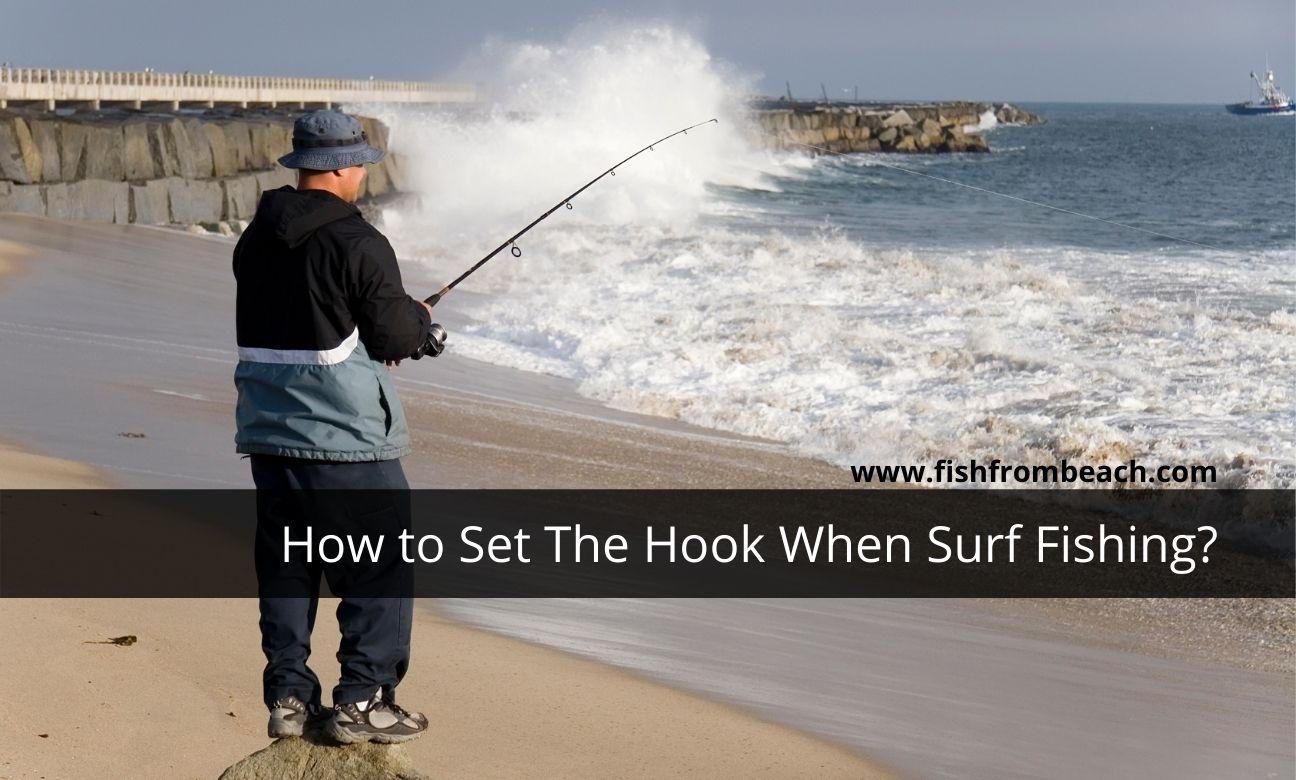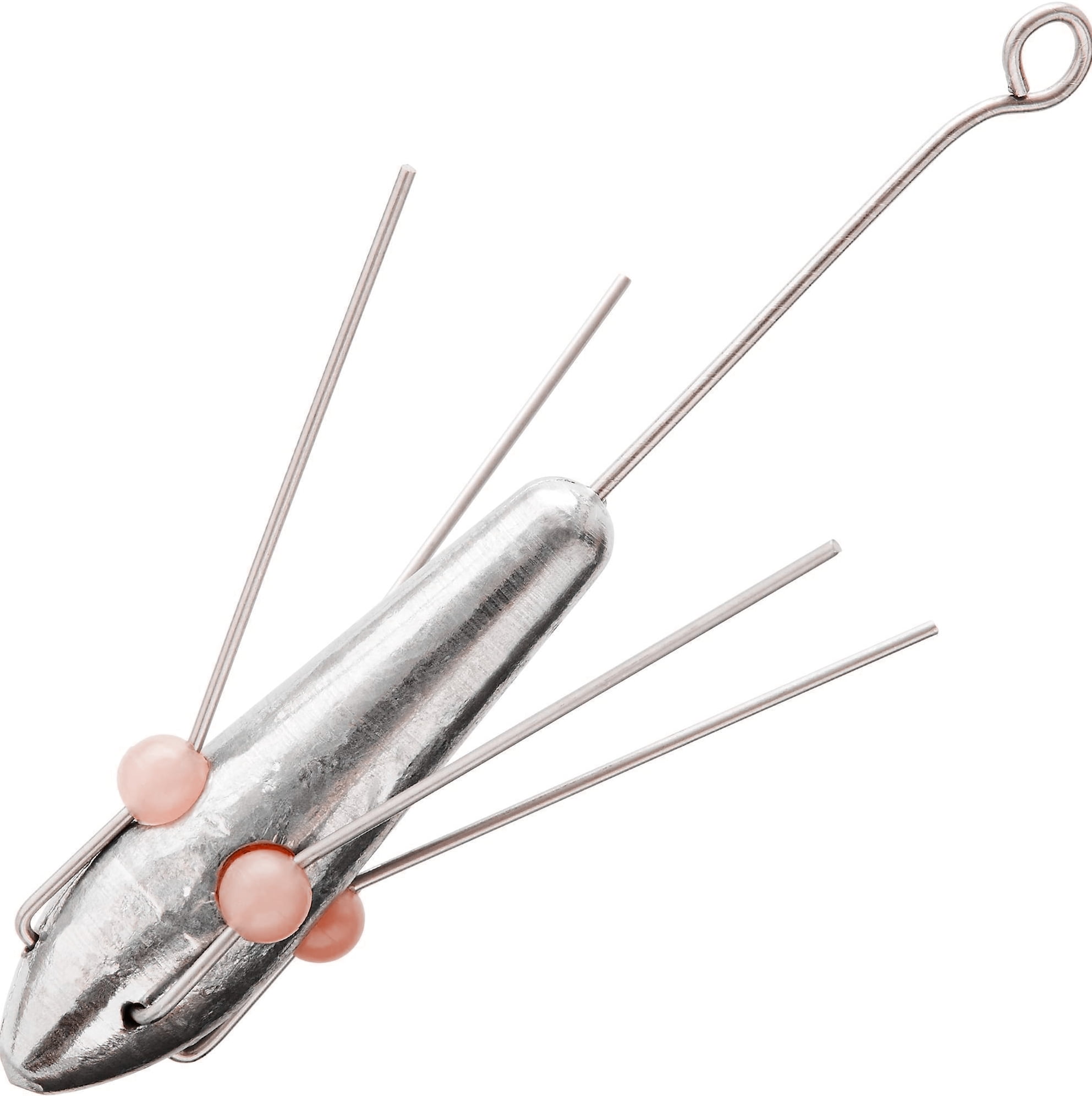
Hook setting is among the most important skills to master if you want to be successful in surf fishing.
Think of it this way…
When fishing off the beach, many things matter and dictate your productivity : The rod length and power, the reel size, the line diameter, the pound test, the drag setting, the rig, the bait, your ability to detect bites, your fighting skills, how you handle the rod…etc.
These are all important factors that determine the number of rewards you get from the shore. However, none of these really matter if you don’t know how to secure the catch when feeding on your bait.
Misperforming in this short and precise moment will cost you a lot of catches no matter how good your gear and what other skills you have.
In other words, hook setting is a real deal-breaker, especially when we are forced to deploy baits tens of yards away from shore.
Yes, the longer your casts, the more chance the fish have to steal your offering and escape the trap, and therefore the more critical the hook setting becomes.
That’s why I decided to write this article and discuss with you how to properly set the hook when surf fishing.
In the next paragraphs, we will find out what does setting the hook mean ? when and why do you need it ? how to succeed at it ? and what other things to consider in order to have better hooksets.
What does the hook setting mean ?
Ok, I suppose you already know what the hook setting means, but if you don’t, let me to tell you what it is in simple words.
Hook setting is a movement that we perform with the rod in order to secure the hook in the mouth of a fish that comes to eat our bait.
Many anglers, especially beginners, think that as soon as fish hit hooks, they will be caught with no chance of backing up.
Well, I have to say this is true for some species with aggressive feeding habits, but the majority of fish are very careful at feeding time and do not swallow food before processing it with their mouths to make sure they are eating something safe. Until then, and if they feel something spooky in their mouth, they will spit it out and go in search of something safer to eat.
Therefore, feeling a bite does not necessarily mean you have the catch. You still need to make sure the fish is not spitting your bait and running away.
That’s where setting the hook setting comes into play.
The goal of a hookset is to secure the hook in the fish’s mouth before it feels the danger. This way, it won’t be able to free it’s mouth until you do it with your hands on the shoreline 😀
Relying only on the bite to catch fish will bring you some trophies, but most fish will manage to escape your trap, either directly after the bite, or during the fight.
How to set the hook from shore ?
The process of hook setting is quite simple and we can break it into 4 steps :
Step 1 : Remove the slack
The first thing to do when you feel a bite is to quickly pick up the line until you restore the feel of the weight (or the fish) at the end of the line.
In other words, you want your line to become completely straight and tense so that you can have the sensitivity you need to perform effective and powerful hooksets.
Slackline is the main reason why hooksets fail. Why? Simply because when you set the hook while a bow is in the line, most of the energy you put on the rod gets absorbed halfway down the line and fails to reach your hook.
It is therefore essential to remove the slack before setting the hook so that you can establish a better connection with your terminal tackle and ensure that the energy you create by pulling the rod will be quickly and efficiently transmitted through the line and will reach the fish biting on your hook.
Step 2 : Lean the rod’s tip forward
Now that your line is straight and you can feel the weight at the end of your line, it’s time to pull the rod and push the hook against the fish’s mouth.
However, before you do this, you must first make sure that you have enough room where to sweep the rod.
This is similar to the casting process where the more you load the rod behind your back, the more room you create for the cast and the greater your reach.
Likewise, in order to perform a better hookset, you need to create some room where you can pull the rod. Otherwise, your move will not be as explosive as it needs to be to pierce the jaw of the fish and many trophies will manage to spit the bait and escape safely.
Ok, I understand. But how can I create room for my hooksets and make them more explosive ?
Well, simply by leaning the pole’s tip seaward. That’s really all it takes.
When you hold a fishing rod parallel to the ground, you keep your shoulders and arms in a comfortable position to provide a quick and long sweep of the rod. This is exactly what you need to have a deadly hookset. More on this in the next step.
Step 3 : Pull up the rod
You have removed the slackline and created enough space for your hookset. Now is the time to pull the rod and push the hook where it should be. In the corner of your favorite fish’s mouth 🙂
Now in this step, there are 3 questions that novice fishermen often ask :
In which direction should I pull the rod ?
There are only 2 possible options here. Either pull the rod up or sweep it horizontally. Now, which one is the best ? The one you find the easiest and most effective.
The most important thing is to choose the direction that allows you to feel comfortable and physically able to apply enough power to make better hooksets.
Personally, I prefer vertical sweeps. But I see many experienced fishermen going horizontally with great success.
How much power should I put on the rod ?
Now, this is a harder question.
The amount of pressure you put on the rod can either make or break your hookset. Why ? Simply because fish mouths are different and as a result require different levels of power in order to penetrate them.
Species like the red snapper and bream have tough jaws and require very powerful hooksets to pierce them.
In contrast, species like the snook and ladyfish have soft lips and should be treated with care so as not to tear them off.
Only experience and years of trial and error will teach you how to determine which fish hits your bait and how much power you need to put on the rod to secure the catch.
Yes, experienced anglers know, in most cases, which fish is on their line just by identifying the type of vibrations they are receiving on their rods and then use that information to adjust the strength of their hooksets.
Until you acquire this level of experience, I would recommend setting your hooks using only 75% of your strength. I believe this is a safe amount of power to apply when you don’t know which type of jaw is on the line.
When to set the hook ?
This is a hard one too.
The way fish deal with baits is different from one species to another. Some require setting the hook as soon as you feel the bite, while others demand waiting a few seconds before pulling the hook.
For instance, fish like flounder and pompano spend some time working and testing the bait before completely swallowing it. When targeting these species, setting the hook too early can result in many lost catches and empty hooks.
On the flip side, species like baby sharks and the striped bass require setting the hook as soon as you feel the strike. Wait longer and the fish is likely to run away with your meal.
Again, only with experience will you be able to know which fish is hitting your hook and when is the right moment to strike back.
With that said, if you are still in your first years of surf fishing and still learning how different species deal with baits, I would suggest being quick with your hooksets. Yes, you risk losing some catches because of that, but I believe the hookup ratio is generally higher when you set the hook systematically after feeling the bite.
Step 4 : Keep pulling the rod and reel in the line
After setting the hook, do not lean the rod back. Keep pulling it and do a quick recovery of the line.
You want to keep the pressure on the fish and use its resistance to your advantage to better penetrate its mouth.
Returning the rod to its original position will create a new slack and give the fish more room and a chance to free its jaw.
Other variables to consider for better hooksets
The shape of your hook
Circle hooks are a must-have for surf fishing. We have discussed in a previous article all the advantages of circle hooks when fishing off the beach. I encourage you to read it because when you finish, you will decide to never go surf fishing without them in your tackle box.
One of the benefits we discussed in this article was the ability of circle hooks to catch biting fish without having to move the rod.
Yes, circle hooks are designed in a way that makes them rotate after bites so that they become more exposed to the mouth’s internal parts and ready to catch something in there.
In other words, once a fish hits the bait, the hook’s point pivots towards the inside of the mouth. Now when the fish tries to run with the bait, the hook starts leaving the mouth and in the process, it grabs the lips and pierces the corner of the fish’s jaw.
With this intelligent design, the odds that the fish spits the hook without getting caught or the hook leaving out the mouth without catching the lips are extremely low. As a result, you don’t need to set the hook when using circle hooks. They will do it for you even when you are busy enjoying the sunset and leaving the rod on a holder 😉
You can’t have that when using J-shaped hooks. The points of these hooks do not head inwards, and therefore, when something bites, you still need to sweep the rod in order to ensure the hook is not backing out empty.
Also, barbed hooks provide better hooksets than non barbed hooks. It’s pretty obvious, I guess. The barb is there to ensure that the hook does not leave the mouth once it penetrates the flesh.
The casting weight
The heavier your sinker, the more resistance it applies to the fish that come to take your bait, the more likely you are to hook some of them without even moving the rod.
Yes, fishing weights are not only useful for improving the casting distance and staying stable in moving waves, but also for providing a better hookup ratio by making it difficult for fish to run around with bait without getting caught.
Using too light weights can adversely affect your performance on the beach. Not only because the current will keep pushing your terminal equipment out of the strike zone, but also because you will lose so many fish that find it easy to work your baits, steal the food, and escape without any problem.
In general, weights weighing between 3 oz and 4 oz are all you need for surf fishing. This range is enough to keep your bait stable where it should be and also to apply the resistance needed to pierce the mouths of fish as they try to run with the bait.
The type of your sinker is also an important factor here. You want something that digs well into the seabed and that is difficult to pull out of the sand.
Personally, I find the breakaway sinker* the best candidate for this thanks to its metal sticks which provide a stronger grip at the bottom.

The rod action
The stiffer your rod, the easier it is to set the hooks.
Let me tell you why…
Fast action rods are highly sensitive and their lack of flexibility helps to transmit energy effectively through the blank. As a result, when you feel a fish on the line, whatever motion you do with the rod in order to set the hook, you will get a quick and accurate outcome of what you intended to achieve.
This provides you with the power and control to set the hook whenever you want. By combining this with the previously discussed knowledge of when and how to set the hooks, you will turn your days on the beach into prolific days with many catches to be proud of.
Conversely, with slow action rods, the high bending capacity they provide absorbs most of the energy you put into them when setting the hook, and therefore, the response to your movements and intentions will be delayed and diminished, and the fish will have more time and chance to escape the hook after the bite.
That’s one of the main reasons why fast tip rods are generally the better choice for surf fishing. As we said, hook setting is more critical when fishing the surf. As a result, you need a fast and sensitive rod so you can have a better connection with the far end of the line.
The line
The stretching capacity of your line also affects your hook setting performance.
Monofilament is stretchy and therefore cushions some of the energy you apply during the hookset and reduces the desired impact on the fish.
Braid performs better during the hookset because it does not stretch and therefore transmit all your power to the other end of the line and gives you exactly what you intended to achieve.
Some recommended surf fishing gear(*)
Note (*): If you make a purchase through links from this website, we may get a small share of the sale from Amazon or other similar affiliate programs.
Surf Fishing Survey
Help us provide you with better content by answering simple questions about your surf fishing experience and knowledge.
We will put the collected responses together and turn them into valuable information that will help you catch more fish from shore 😉
Note: No personal information will be collected with your answer.

